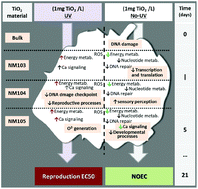Our official English website, www.x-mol.net, welcomes your feedback! (Note: you will need to create a separate account there.)
Mechanisms of (photo)toxicity of TiO2 nanomaterials (NM103, NM104, NM105): using high-throughput gene expression in Enchytraeus crypticus†
Nanoscale ( IF 6.7 ) Pub Date : 2018-10-25 00:00:00 , DOI: 10.1039/c8nr03251c Susana I. L. Gomes 1, 2, 3, 4 , Carlos P. Roca 5, 6, 7, 8 , Frank von der Kammer 9, 10, 11, 12 , Janeck J. Scott-Fordsmand 5, 6, 7, 8 , Mónica J. B. Amorim 1, 2, 3, 4
Nanoscale ( IF 6.7 ) Pub Date : 2018-10-25 00:00:00 , DOI: 10.1039/c8nr03251c Susana I. L. Gomes 1, 2, 3, 4 , Carlos P. Roca 5, 6, 7, 8 , Frank von der Kammer 9, 10, 11, 12 , Janeck J. Scott-Fordsmand 5, 6, 7, 8 , Mónica J. B. Amorim 1, 2, 3, 4
Affiliation

|
Titanium dioxide (TiO2) based nanomaterials (NMs) are among the most produced NMs worldwide. When irradiated with light, particularly UV, TiO2 is photoactive, a property that is explored for several purposes. There are an increasing number of reports on the negative effects of photoactivated TiO2 on non-target organisms. We have here studied the effect of a suite of reference type TiO2 NMs (i.e. NM103, NM104, and NM105 and compared these to the bulk) with and without UV radiation to the oligochaete Enchytraeus crypticus. High-throughput gene expression was used to assess the molecular mechanisms, while also anchoring it to the known effects at the organism level (i.e., reproduction). Results showed that the photoactivity of TiO2 (UV exposed) played a major role in enhancing TiO2 toxicity, activating the transcription of oxidative stress, lysosome damage and apoptosis mechanisms. For non-UV activated TiO2, where toxicity at the organism level (reproduction) was lower, results showed potential for long-term effects (i.e., mutagenic and epigenetic). NM specific mechanisms were identified: NM103 affected transcription and translation, NM104_UV negatively affected the reproductive system/organs, and NM105_UV activated superoxide anion response. Results provided mechanistic information on UV-related phototoxicity of TiO2 materials and evidence for the potential long-term effects.
中文翻译:

的TiO(照片)的毒性的机制2个纳米材料(NM103,NM104,NM105):使用高通量的基因表达Enchytraeus crypticus †
基于二氧化钛(TiO 2)的纳米材料(NMs)是全球生产最多的NMs之一。当用光特别是紫外线照射时,TiO 2具有光活性,这一特性已被探索用于多种目的。关于光活化的TiO 2对非目标生物的负面影响的报道越来越多。我们在这里研究了一组参考类型的TiO 2 NMs(即NM103,NM104和NM105)的效果,并在不使用UV辐射的情况下,对寡头En鱼隐藻进行了比较。高通量基因表达用于评估分子机制,同时还将其锚定在生物体水平上的已知作用(即, 再生产)。结果表明,TiO 2的光活性(暴露于紫外线下)在增强TiO 2毒性,激活氧化应激的转录,溶酶体破坏和细胞凋亡机制中起主要作用。对于非紫外线活化的TiO 2,其在生物体水平(繁殖)的毒性较低,结果表明具有长期作用(即诱变和表观遗传学)的潜力。确定了NM的特定机制:NM103影响转录和翻译,NM104_UV负面影响生殖系统/器官,以及NM105_UV激活的超氧阴离子反应。结果提供了有关TiO 2的紫外线相关光毒性的机理信息 潜在的长期影响的材料和证据。
更新日期:2018-10-25
中文翻译:

的TiO(照片)的毒性的机制2个纳米材料(NM103,NM104,NM105):使用高通量的基因表达Enchytraeus crypticus †
基于二氧化钛(TiO 2)的纳米材料(NMs)是全球生产最多的NMs之一。当用光特别是紫外线照射时,TiO 2具有光活性,这一特性已被探索用于多种目的。关于光活化的TiO 2对非目标生物的负面影响的报道越来越多。我们在这里研究了一组参考类型的TiO 2 NMs(即NM103,NM104和NM105)的效果,并在不使用UV辐射的情况下,对寡头En鱼隐藻进行了比较。高通量基因表达用于评估分子机制,同时还将其锚定在生物体水平上的已知作用(即, 再生产)。结果表明,TiO 2的光活性(暴露于紫外线下)在增强TiO 2毒性,激活氧化应激的转录,溶酶体破坏和细胞凋亡机制中起主要作用。对于非紫外线活化的TiO 2,其在生物体水平(繁殖)的毒性较低,结果表明具有长期作用(即诱变和表观遗传学)的潜力。确定了NM的特定机制:NM103影响转录和翻译,NM104_UV负面影响生殖系统/器官,以及NM105_UV激活的超氧阴离子反应。结果提供了有关TiO 2的紫外线相关光毒性的机理信息 潜在的长期影响的材料和证据。



























 京公网安备 11010802027423号
京公网安备 11010802027423号